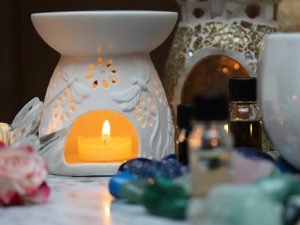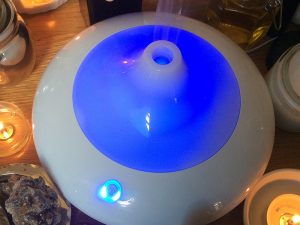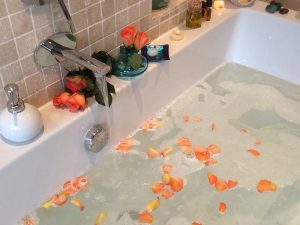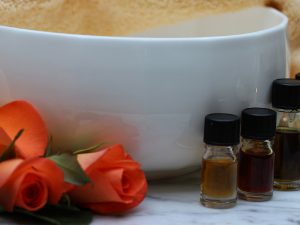- info@aromantique.co.uk
- 07419 777 451
The following information contains excerpts from my books, Healing with Essential Oils, Essential Oils for the Whole Body and Essential Oils for Mindfulness and Meditation (published by Healing Arts Press, Vermont USA)
Here are some safe home-use methods of application. For other methods and further information, please refer to my books: Healing with Essential Oils, Essential Oils for the Whole Body, and Essential Oils for Mindfulness and Meditation
 Candle-lit room diffuser
Candle-lit room diffuser
Add water to the bowl. Add 6 to 8 drops of a single essential oil or an essential oil blend. Light candle. Replenish as necessary.
Candle-lit diffusers with deep water bowls are preferable (to avoid rapid drying out). Keep a small jug of water at hand to replenish, and do not allow the water bowl to dry out.
Do not leave unattended – ensure the candle is extinguished before leaving unattended. Place the diffuser in a safe and stable position, where it cannot be knocked over (candles and essential oils are a fire risk) or touched by children or pets.
Do not diffuse essential oils close to people’s heads. If using a diffuser in a communal area, such as an office or waiting room, always check that other people like the oils you are diffusing and/or do not have respiratory problems that may be irritated by essential oil molecules.

These usually come with instructions regarding appropriate operation and use. Add 6 to 8 drops of an essential oil or essential oil blend. Replenish as necessary.
Rather than leaving the diffuser on constantly, use in short ‘bursts’ at chosen convenient times. Remember, the sense of smell soon becomes saturated; the brain stops acknowledging smells after a short period of time, even though they may still be present (leaving and returning to a room, the odour is re-acknowledged; this may be a good indication of whether the essential oils need replenishing).
Just as with candle-lit diffusers, above, do not diffuse essential oils close to people’s heads. If using a diffuser in a communal area, such as an office or waiting room, always check that other people like the oils you are diffusing and/or do not have respiratory problems that may be irritated by essential oil molecules.
 Baths
Baths
Fill bath with water, then, just before getting in, add 6 drops of essential oil or an essential oil blend dispersed in 20 ml of vegetable oil. Do not use essential oils neat in the bath. To maximize benefit, close windows and doors.
Remember, vegetable oil makes the bath slippery.
Do not leave children unattended in a bath.
Essential oils are mostly absorbed into the body’s system via inhalation of odour-infused steam when applied in a bath, rather than via the epidermis (skin) (most of the essential oils molecules evaporate from the waters surface). Although wetting and soaking the skin with warm water may assist some epidermal absorption of essential oil molecules, it also increases the risk of skin irritation. Also, hot or warm baths tend to encourage perspiration (excretion) rather than absorption through sweat glands.
Also, water itself is very ‘drying’ to the skin, and when combined with neat essential oils, this drying effect is increased. Essential oils, therefore, should be dispensed in an oily or fatty carrier medium (emollient) such as grape seed or olive oil oil; thus an oily barrier is created that may prevent essential oil irritation and reduce the ‘drying’ effect of water to the skin.
A better option is to diffuse the essential oil(s) into the atmosphere, or to apply the essential oils topically in a non-perfumed lotion, cream or vegetable oil after bathing, while the skin is hydrated and warm; thus also slowing down water loss through evaporation after bathing and aiding moisturisation and suppleness of the dermis through creating a gentle barrier and improving absorption of the essential oils.
CAUTION: ESSENTIAL OILS THAT SHOULD NOT BE USED IN THE BATH
Basil, Cinnamon, Clove, Peppermint, Thyme, Citrus oils or lemon-scented oils.

You will need: a kettle (or pan), water, bowl, tissues, essential oils and a large towel. Before commencing, ensure that your equipment is placed in a safe position, away from pets and children and on a stable surface.
Heat the water to boiling point. Very carefully pour boiled water from the kettle (or pan) into the bowl (preferably heat proof ceramic, glass or pottery – do not use plastic bowls). Allow the water to cool slightly (essential oils will vaporise too rapidly otherwise). Add 2 to 4 drops of your selected essential oil or blend of essential oils to the water (replace essential oil bottle lids immediately).
Cover your head and the bowl with the large towel to contain the rising essential oil infused steam vapours – CLOSE YOUR EYES. Breathe vapours through your nose, exhale through your mouth, for a few minutes. Remove towel (‘come up for air’). Replenish water and essential oils if necessary and repeat exercise two or three times.
Stop immediately if you experience any irritation, or feel dizzy. Essential oils will irritate the mucous membrane to a certain degree; use moderately and do not exceed the above dose. Caution must be applied if the recipient has sensitivities, asthma or epilepsy (always check a particular oil is not contraindicated and, if safe to use, only use half the above dose – 1 to 2 drops of essential oils).
For further information about these and other methods of application, and the safe and effective use of essential oils, please refer to:
Essential Oils for the Whole Body
Essential oils for Mindfulness and Meditation